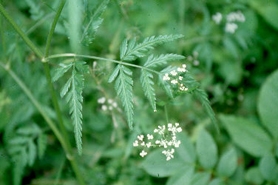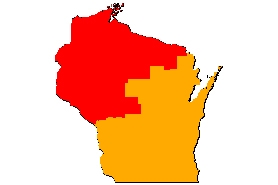Japanese hedgeparsley
(Torilis japonica)
Herbaceous biennial in the carrot family, with white umbel flowers and parsley-like leaves. Flowering plants are branched and grow 2-6 feet tall.
Other names for this plant include:
- Common names: erect hedgeparsley, upright hedgeparsley
- Scientific names: T. anthriscus; T. rubella; Caucalis japonica
Classification in Wisconsin: Prohibited/Restricted (Restricted in Adams, Brown, Calumet, Columbia, Crawford, Dane, Dodge, Door, Fond du Lac, Grant, Green, Green Lake, Iowa, Jefferson, Juneau, Kenosha, Kewaunee, La Crosse, Lafayette, Langlade, Manitowoc, Marathon, Marinette, Marquette, Menominee, Milwaukee, Monroe, Oconto, Outagamie, Ozaukee, Portage, Racine, Richland, Rock, Sauk, Shawano, Sheboygan, Vernon, Walworth, Washington, Waukesha, Waupaca, Waushara, and Winnebago counties. Prohibited elsewhere)
- Ecological Threat
-
- Hedgeparsleys invade forests, grassland, hedgerows and roadsides.
- Currently, only Japanese hedgeparsley is known in Wisconsin.
- Pets, such as dogs and other animals appear to spread Japanese hedgeparsley quickly throughout the state.
- Identification
-
Leaves: First-year plants have low-growing, parsley-like rosettes that stay green until late fall. Second-year plant leaves are alternate, compound, fern-like, 2-5 inches long and slightly hairy.
Flowers: Flowers are tiny and white, growing in small, open, flat-topped umbels. It has two or more bracts at the base of each umbel—blooms in July and August.
Fruits & seeds: The small fruit ripens quickly and is covered in hooked hairs that attach to clothing and fur.
Roots: Taproot.
Similar species: Queen Anne's lace or wild carrot (Daucus carota; non-native)—a widespread weed in Wisconsin—has similar finely-divided leaves, but leaves and stems are pretty hairy and when crushed smell like carrots. Other look-alikes include wild chervil (Anthriscus sylvestris; invasive), caraway (Carum carvi; non-native), poison hemlock (Conium maculatum; invasive), Chinese hemlock parsley (Conioselinum chinense; non-native), sweet cicely (Osmorhiza spp.; native) and spreading hedge parsley. Spreading hedge-parsley (Torilis arvensis; invasive) is not currently known in Wisconsin, but nationally is more common than T. japonica. It looks very similar to Japanese hedge-parsley but lacks the pointed bracts at the base of each umbel.
- Control
-
Mechanical: Pull or mow before flowering.
Chemical: Treat foliage with glyphosate, triclopyr, or metsulfron methyl in early spring or on plants that are resprouting after being cut.
For more information on control techniques, visit the Hedgeparsley factsheet [exit DNR] by the University of Wisconsin-Extension.
- Resources
- Sources for content:
- Czarapata, Elizabeth; Invasive Plants of the Upper Midwest: an illustrated guide to their identification and control. The University of Wisconsin Press. 2005. Pg. 140
- Fewless, Gary. Herbarium, Coffrin Center for Biodiversity, UW-Green Bay. Invasive Plants of Wisconsin. Torilis japonica [exit DNR].
- Invasive Plant Atlas of the United States. Japanese hedgeparsley [exit DNR]. Last updated December 21, 2011.



